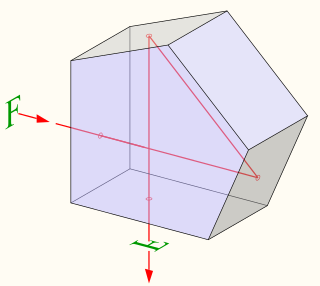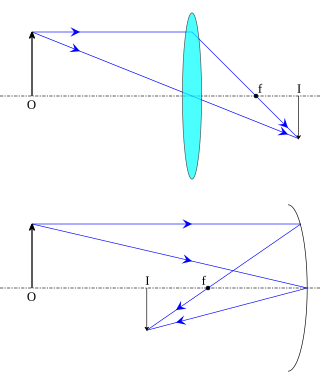In optics, an erect image is one that appears right-side up. An image is formed when rays from a point on the original object meet again after passing through an optical system. In an erect image, directions are the same as those in the object, in contrast to an inverted image. It is one of the properties of images formed in a plane mirror. Some telescopes and other devices such as the camera obscura present an inverted image on the viewing surface. Mirrors and compound prism elements can be used to achieve an erect image instead.

In mathematics, an endomorphism is a morphism from a mathematical object to itself. An endomorphism that is also an isomorphism is an automorphism. For example, an endomorphism of a vector space V is a linear map f: V → V, and an endomorphism of a group G is a group homomorphism f: G → G. In general, we can talk about endomorphisms in any category. In the category of sets, endomorphisms are functions from a set S to itself.

A mirror, also known as a looking glass, is an object that reflects an image. Light that bounces off a mirror will show an image of whatever is in front of it, when focused through the lens of the eye or a camera. Mirrors reverse the direction of the image in an equal yet opposite angle from which the light shines upon it. This allows the viewer to see themselves or objects behind them, or even objects that are at an angle from them but out of their field of view, such as around a corner. Natural mirrors have existed since prehistoric times, such as the surface of water, but people have been manufacturing mirrors out of a variety of materials for thousands of years, like stone, metals, and glass. In modern mirrors, metals like silver or aluminium are often used due to their high reflectivity, applied as a thin coating on glass because of its naturally smooth and very hard surface.

Optics is the branch of physics that studies the behaviour and properties of light, including its interactions with matter and the construction of instruments that use or detect it. Optics usually describes the behaviour of visible, ultraviolet, and infrared light. Because light is an electromagnetic wave, other forms of electromagnetic radiation such as X-rays, microwaves, and radio waves exhibit similar properties.

A camera obscura is a darkened room with a small hole or lens at one side through which an image is projected onto a wall or table opposite the hole. The image of lensless camera obscuras is also referred to as "pinhole image".

A mirage is a naturally-occurring optical phenomenon in which light rays bend via refraction to produce a displaced image of distant objects or the sky. The word comes to English via the French (se) mirer, from the Latin mirari, meaning "to look at, to wonder at".

A mirror image is a reflected duplication of an object that appears almost identical, but is reversed in the direction perpendicular to the mirror surface. As an optical effect it results from reflection off from substances such as a mirror or water. It is also a concept in geometry and can be used as a conceptualization process for 3-D structures.

A telephoto lens, in photography and cinematography, is a specific type of a long-focus lens in which the physical length of the lens is shorter than the focal length. This is achieved by incorporating a special lens group known as a telephoto group that extends the light path to create a long-focus lens in a much shorter overall design. The angle of view and other effects of long-focus lenses are the same for telephoto lenses of the same specified focal length. Long-focal-length lenses are often informally referred to as telephoto lenses, although this is technically incorrect: a telephoto lens specifically incorporates the telephoto group.

A pentaprism is a five-sided reflecting prism used to deviate a beam of light by a constant 90°, even if the entry beam is not at 90° to the prism. The beam reflects inside the prism twice, allowing the transmission of an image through a right angle without inverting it as an ordinary right-angle prism or mirror would.

An optical telescope is a telescope that gathers and focuses light mainly from the visible part of the electromagnetic spectrum, to create a magnified image for direct visual inspection, to make a photograph, or to collect data through electronic image sensors.

Magnification is the process of enlarging the apparent size, not physical size, of something. This enlargement is quantified by a size ratio called optical magnification. When this number is less than one, it refers to a reduction in size, sometimes called de-magnification.
Geometrical optics, or ray optics, is a model of optics that describes light propagation in terms of rays. The ray in geometrical optics is an abstraction useful for approximating the paths along which light propagates under certain circumstances.

In optics, the image of an object is defined as the collection of focus points of light rays coming from the object. A real image is the collection of focus points made by converging rays, while a virtual image is the collection of focus points made by extensions of diverging rays. In other words, a virtual image is found by tracing real rays that emerge from an optical device backward to perceived or apparent origins of ray divergences. For a (refracting) lens, the real image of an object is formed on the opposite side of the object while the virtual image is formed on the same side of the object. For a (reflecting) mirror, the real image is on the same side of the object while the virtual image is the opposite side to the object. In diagrams of optical systems, virtual rays are conventionally represented by dotted lines, to contrast with the solid lines of real rays.

In optics, an image is defined as the collection of focus points of light rays coming from an object. A real image is the collection of focus points actually made by converging/diverging rays, while a virtual image is the collection of focus points made by extensions of diverging or converging rays. In other words, it is an image which is located in the plane of convergence for the light rays that originate from a given object. Examples of real images include the image produced on a detector in the rear of a camera, and the image produced on an eyeball retina.

A curved mirror is a mirror with a curved reflecting surface. The surface may be either convex or concave. Most curved mirrors have surfaces that are shaped like part of a sphere, but other shapes are sometimes used in optical devices. The most common non-spherical type are parabolic reflectors, found in optical devices such as reflecting telescopes that need to image distant objects, since spherical mirror systems, like spherical lenses, suffer from spherical aberration. Distorting mirrors are used for entertainment. They have convex and concave regions that produce deliberately distorted images. They also provide highly magnified or highly diminished (smaller) images when the object is placed at certain distances.

A star diagonal, erecting lens or diagonal mirror is an angled mirror or prism used in telescopes that allows viewing from a direction that is perpendicular to the usual eyepiece axis. It allows more convenient and comfortable viewing when the telescope is pointed at, or near the zenith. Also, the resulting image is right side up, but is reversed from left to right.

A plane mirror is a mirror with a flat (planar) reflective surface. For light rays striking a plane mirror, the angle of reflection equals the angle of incidence. The angle of the incidence is the angle between the incident ray and the surface normal. Therefore, the angle of reflection is the angle between the reflected ray and the normal and a collimated beam of light does not spread out after reflection from a plane mirror, except for diffraction effects.
A delta prism is an optical element providing a compact folded form of the Dove prism. When used in the normal orientation, the prism inverts the image ; rotating the orientation results in image rotation to other arbitrary angles.

A projector or image projector is an optical device that projects an image onto a surface, commonly a projection screen. Most projectors create an image by shining a light through a small transparent lens, but some newer types of projectors can project the image directly, by using lasers. A virtual retinal display, or retinal projector, is a projector that projects an image directly on the retina instead of using an external projection screen.
In optics, a relay lens is a lens or a group of lenses that receives the image from the objective lens and relays it to the eyepiece. Relay lenses are found in refracting telescopes, endoscopes, and periscopes to optically manipulate the light path, extend the length of the whole optical system, and usually serve the purpose of inverting the image. They may be made of one or more conventional lenses or achromatic doublets, or a long cylindrical gradient-index of refraction lens.

Upside down goggles, also known as "invertoscopes" by Russian researchers, are optical instruments that invert the image received by the retinas upside down. They are used to study human visual perception, particularly psychological process of building a visual image in the brain. Objects viewed through such a device appear upside down and mirrored. They are constructed using sets of optical right-angle prisms, concave mirrors, or a mirror plus right-angle prisms with unequal cathethus.